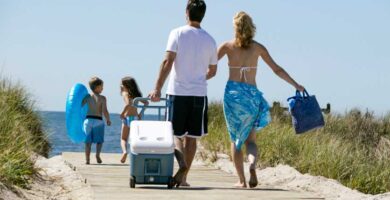April 4, 2025

🧊 Igloo Trailmate Cooler
April 4, 2025

Beach Cooler with Wheels: The Ultimate Buying Guide
April 1, 2025

Best Yeti Cooler for Beach: Top Picks for Ice-Cold
Nothing ruins a beach day faster than warm drinks and soggy snacks. That’s where the right beach cooler makes all the difference. Whether you’re planning a relaxing solo escape, a family picnic by the waves, or a full-blown beach party, a high-performance cooler is essential.
In this guide, we’ll walk you through everything you need to know — from choosing the right type and features to avoiding common mistakes. Plus, we’ll share our top picks for the top rated beach coolers of 2024.
Why a Good Beach Cooler Is Essential
You might think any ice cooler can handle the beach — but once you’re dragging it across hot sand or trying to keep ice from melting in the sun, you’ll realize that not all coolers are built for the beach.
Here’s why investing in a proper beach cooler is worth it:
- Keeps drinks cold for hours (or days)
- Withstands sand, sun, and saltwater exposure
- Easy to carry across uneven terrain
- Protects your food and beverages from overheating
- Improves your overall beach experience
From insulation performance to portability, the details really do matter.
According to the FDA, perishables should not stay above 40°F for more than 2 hours — beach coolers help avoid this.
🔍 Top Features to Look for in a Beach Coolers
Before buying a cooler for your beach trips, consider these key features:
✅ 1. Insulation & Ice Retention
Look for coolers with thick insulated walls and tight seals. Some can keep ice frozen for up to 5 days.
Pro Tip: Look for models with rubber gasket lids or Ultratherm® insulation for longer-lasting cooling.
✅ 2. Size & Capacity
Choose based on your group size:
- Small (12–20 quarts): Personal use
- Medium (25–40 quarts): Couples or short family trips
- Large (50+ quarts): Full-day outings or big groups
Some coolers are designed to hold up to 100 cans — great for parties!
✅ 3. Portability
A true beach cooler should be easy to carry. Look for:
- Wheels (especially large all-terrain ones)
- Telescoping handles
- Shoulder straps (for soft coolers or backpacks)
✅ 4. Material
You’ll find two main types:
- Hard coolers: Rigid, durable, excellent insulation
- Soft coolers: Lightweight, flexible, easier to carry
Choose depending on how far you walk to your beach spot and how long you stay.
✅ 5. Extra Features
Little things make a big difference:
- Built-in bottle opener
- Cup holders
- Dry storage compartment
- Drain plug for melted ice
- UV-resistant shell
Top 5 Best Beach Coolers of 2024 (Editor’s Picks)
| Cooler | Type | Capacity | Ice Retention | Key Features | Price Range |
|---|---|---|---|---|---|
| YETI Tundra 45 | Hard Cooler | 37 quarts | Up to 3–5 days | Ultra-durable, bear-resistant, heavy-duty insulation | $$$$ |
| Igloo Trailmate Journey 70 | Wheeled | 70 quarts | Up to 4 days | Large wheels, dry storage, bottle opener, tray table | $$$ |
| RTIC Soft Pack 30 | Soft Cooler | 30 cans | Up to 2 days | Lightweight, leak-proof, easy to carry | $$ |
| Coleman Xtreme 5 | Hard Cooler | 50 quarts | Up to 5 days | Budget-friendly, solid insulation, built-in cup holders | $ |
| TOURIT Backpack Cooler | Backpack | 30 cans | Up to 16 hours | Ultra-portable, waterproof zippers, multiple pockets | $$ |
Types of Beach Coolers: Which One Fits Your Lifestyle?
Not all beach coolers are created equal — and that’s a good thing. The best type of cooler for you depends on how you hit the beach: Do you hike in with minimal gear? Roll up with a big group? Need your hands free for kids or surfboards?
Here’s a breakdown of the most common types of beach coolers and what they’re best for:
🧱 1. Hard-Shell Coolers (Rigid Coolers)
Best for: Maximum ice retention & large groups
- Built with solid plastic or metal exteriors
- Retain ice for 2–5 days (or more)
- Durable and often stackable
- Great for long beach days or camping by the sea
- Examples: YETI Tundra, Coleman Xtreme, RTIC Ultra-Light
Downsides: Heavier and bulkier, not ideal for long walks
🛞 2. Wheeled Coolers
Best for: Beaches with long walks or soft sand
- Feature large wheels and telescoping handles
- Make it easy to transport heavy loads
- Some include cup holders, trays, and dry storage
- Examples: Igloo Trailmate, Coleman Chiller, ROVR RollR
Downsides: Slightly heavier and more expensive
🎒 3. Backpack Coolers
Best for: Travelers, solo beachgoers, or hands-free convenience
- Insulated compartments in backpack format
- Lightweight, compact, and great for short trips
- Some have multiple compartments and waterproof zippers
- Examples: TOURIT, YETI Hopper M20, Hydro Flask Carry Out
Downsides: Lower capacity and shorter ice retention (6–16 hrs)
🧵 4. Soft-Sided Coolers
Best for: Portability and quick trips
- Lightweight and flexible
- Easy to store or fold when not in use
- Great for couples or light packers
- Examples: RTIC Soft Pack, AO Coolers, Arctic Zone Titan
Downsides: Less durable and usually keep ice for 1–2 days
🏖️ 5. Bucket or Hybrid Coolers
Best for: Versatile, all-purpose beach trips
- Round or square, mid-size capacity
- Often include unique features like built-in speakers, wheels, or bottle openers
- Stylish and functional for social beachgoers
- Examples: KoolMAX, Coolest Cooler
Downsides: May lack top-tier ice retention or be bulky
💡 Which One Should You Choose?
| Lifestyle / Need | Recommended Cooler Type |
|---|---|
| Long full-day beach trips | Rigid or wheeled cooler |
| Solo or couple day trips | Soft or backpack cooler |
| Remote or sandy beaches | Large wheels or backpack |
| Need hands free | Backpack cooler |
| Budget-friendly option | Coleman Xtreme or soft-sided |



